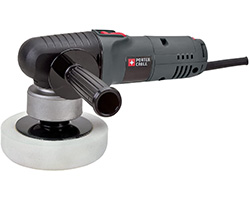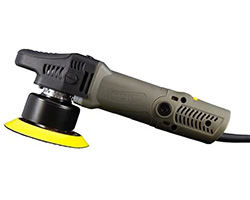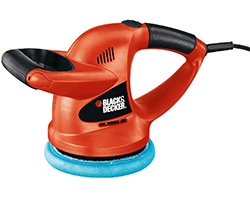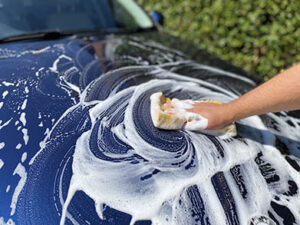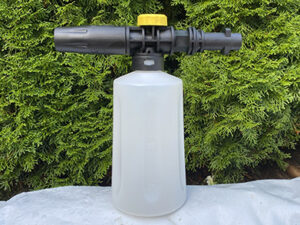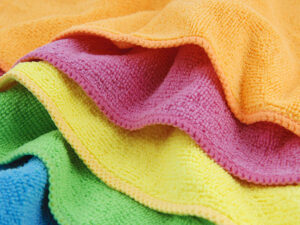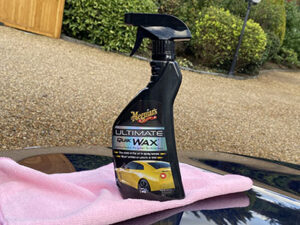Home \ Shop \ Car Care & Detailing \ Buffing Machines For Car
The Best Car Buffers For Effective Polishing – Buyer’s Guide
- 1. Review Of The Best Buffing Machines For Car
- 2. PORTER-CABLE Variable Speed Polisher
- 3. Chemical Guys TORQX Polisher
- 4. BLACK&DECKER Orbital Polisher
- 5. What to Look for When Buying a Buffing Machine?
- 6. How to Buff or Polish a Car?
- 7. What is the difference between "buffing" and "polishing"?
- 8. Is your car's glass allowed to be polished with a polishing machine?
- 9. Can I polish my car by hand instead of machine-buffing?
- 10. Conclusion
Have you ever wondered what exactly a buffing machine does and if this is something you might need? These power tools are simple to use and will allow you to keep your car in a mint condition. Or if the paintwork on your car is faded and dull, they can help restore its shiny appearance. Because of this, a buffing machine is an important item in any car enthusiasts’ tool collection. However, there is a wide range of different models on the market, and choosing the right one may be difficult. To make this easier, we will go through a selection of several buffing machines and explain how to pick the best one.
Review Of The Best Buffing Machines For Car
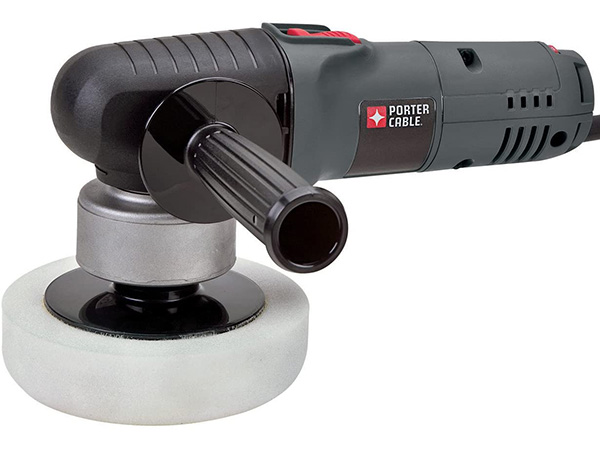
PROS
- Comes packed with accessories
- Adjustable speed levels
- Excellent vibration damping
- Three-year replacement warranty
CONS
- Confusing speed adjustment levels
- May feel a bit weak
MAIN CHARACTERISTICS
BRAND
PORTER-CABLEMODEL
7424XPWEIGHT
5.75 lbPRICE RANGE
$130
Porter-Cable is a reputable name when it comes to various power tools with a rich history that dates back to the early 1900s. Being a renowned maker of power tools, Porter-Cable also manufactures some really capable yet affordable car buffing machines. These are some of their best-performing products, both in terms of sales & overall user feedback. This alone is a testament to the quality of the company’s products.
One of the two buffing machines by Porter-Cable is their Variable Speed Polisher which, as the name suggests, provides different levels of speed adjustments, thus enabling you to detail your car with pinpoint accuracy. With a power rating of nearly 500 W, this corded buffer is suitable for both amateur and professional use by detailing garages. Speaking of professional use, it is necessary to mention that working with any high-speed rotating machine can be demanding. To help with that, the company has fitted this polisher with a proprietary counter-balancer, which absorbs all unwanted vibrations. Additional features include the use of lightweight yet sturdy materials and a removable handle. This provides extra comfort and maximum control when using the polisher for prolonged durations.
Good as it may be, Porter-Cable’s buffing machine is not perfect, as there are some downsides to it. To begin with, the speed adjuster shows numbers ranging from 1 to 6 instead of actual RPMs. This can be a bit confusing when trying the speed according to your buffing needs. Furthermore, the vibration damping may not be less effective at higher speeds, which can cause discomfort in the long run. Nevertheless, Porter-Cable’s corded buffer has all that a good buffer should have, as the pros outweigh the cons by some margin.
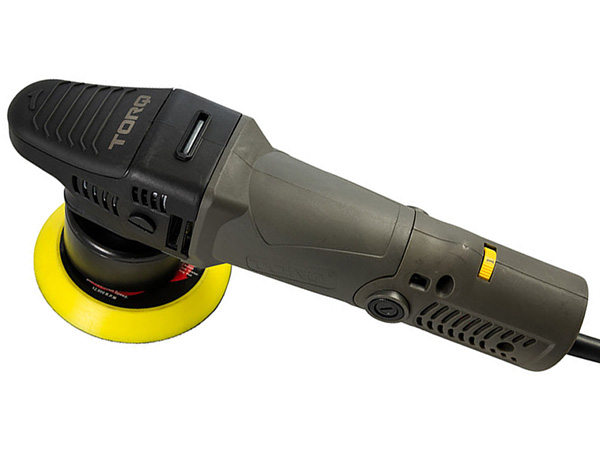
PROS
- Great for both amateurs & professionals
- Excellent ergonomics
- Operates within a wide spectrum of power bands
- Suitable for waxing, buffing & polishing
CONS
- Relatively expensive
- Not suitable for heavy-duty tasks
MAIN CHARACTERISTICS
BRAND
TorqMODEL
BUF503XWEIGHT
8.6 lbsPRICE RANGE
$160
Torq may not be the most familiar name among power tools, but it is well known in the car care world. Many detailers are well aware that this is a highly regarded manufacturer of professional buffing machines. This company offers four different products of this sort, with each aiming to meet the needs of different kinds of customers. The one on this list is more suited for average users, although professionals can use it for less demanding jobs.
Designated as BUF_503X, this buffing machine may sound like a complex device, although being quite the opposite in real-world applications. This particular model is excellent for professional use and comes together with a range of Chemical Guys car care products. With a 680 W motor, this machine will buff out even the harshest waxes, which is not something every polisher can do. Ergonomics are the key concerns for professional users, which is why Torq has designed this buffer to be light and compact. The buffing machine can operate in a wide RPM power range, which comes in handy when working with different types of compounds.
Just like any other product, the Torq buffing machine does have some drawbacks. Although being quite powerful, the electric motor may not have enough grunt for heavy-duty applications. This alone may be a setback for potential buyers who push their tools to the limit. Moreover, not everyone would be content with the price tag, which is set on a relatively higher side.

PROS
- Lightweight & easy to hold
- Backed by a 2-year warranty
- Extra-long cord
- Comes packed with accessories
- Great for beginners
CONS
- Not suitable for heavy-duty tasks
- May seem a bit fragile
MAIN CHARACTERISTICS
BRAND
Black & DeckerMODEL
WP900WEIGHT
2.05 lbsPRICE RANGE
$45
Black & Decker has a global footprint in power tools and it is difficult to name a product this company doesn’t manufacture. Known for providing quality products at highly competitive prices, their Random Orbit Polisher is probably one of the most affordable on the market. Unlike popular belief, a low-price tag doesn’t necessarily translate into bad quality, which is exactly the case for this value-packed device.
To begin with, this buffing machine is the lightest one in this selection, tipping the scale at just 2 pounds. Furthermore, its 10 feet long cord will make maneuvering around even the largest trucks easy without staying close to the socket. Despite the compact dimensions, this buffing machine still has two handles, just like many traditional devices of this sort. Not only does this feature help reduce fatigue, but it also ensures a comfortable position while detailing the car. Remaining true to its tradition of providing the best value, this Black & Decker machine comes with a range of extra goodies. This includes polishing bonnets, a foam applicator, and a large waxer. In addition to that, this highly affordable polisher comes with a 2-years warranty, which is not that common with budget products.
Still, being a budget device also means the company had to cut some corners to keep its price low. For instance, there are no speed adjustment levels, and the body sometimes may feel a bit fragile. However, it is important to mention here that the overall quality is exceptional for a polisher that has such a low price tag. All in all, Black & Decker’s machine is a great product that unarguably delivers the best value for the money.
What to Look for When Buying a Buffing Machine?
At first glance, a buffing machine looks like an oversized angle grinder with some foamy padding attached to it. There are, however, several differences between these tools, which is also something to look for when buying one. For a start, a good buffing machine will feature a dual-action movement, and it is better to avoid those without it. Simply explained, this means that the disc that holds the pad will both rotate and move sideways while polishing. This mimics how a person would buff a car by hand and ensures there are no swirl marks left behind.
Another important aspect is the polishing pad, which comes in several forms, with each one having a different purpose. A standard foam pad is the most common and widely used type among both enthusiasts and professional detailers. They are available in different sizes and gradings, with harder ones being used for buffing and softer ones for polishing. This ensures an optimum and most suited application depending on the vehicle, type of paint, and its condition. There are also microfiber pads, which are similar to foamy ones but with an additional layer of soft synthetic fiber. Many detailers prefer these pads, as they give the paint a more soft appearance. In the end, there are thick wool pads, which are one of the oldest types in the detailing industry. They generate a lot of heat while rotating and are only suitable for older cars and solvent-based paints.
Lastly, the speed at which the polishing pad rotates needs to be within a certain range and easy to control. This allows its adjustments depending on the surface type and the area of the car that is being polished. In most cases, these speeds should vary between 1000 RPM for buffing to over 5000 RPM for fine polishing and waxing.

How to Buff or Polish a Car?
When going through tutorials about car polishing on YouTube and automotive blogs, car owners may find confusing and oftentimes contradictory information. This can make it look difficult, although the whole procedure breaks down into several steps, and following them ensures the best results. It all starts with a thorough wash using hot water and car shampoo, which will remove dust and mud. The car will look clean after that, although small dirt particles and other contaminants may still be sticking to its paint. These would cause damage during the polishing procedure, so it is necessary to remove them using a clay bar. Together with a specialized lubricant, this fiber putty dissolves and pulls all embedded contaminants out of the paint. This can also be a good time to check all body panels for rust or other sorts of damage.
Once the paint is clean and free of any dirt or other particles, it is ready for polishing. But before starting with this, it may be a good idea to protect the surrounding plastic trim with masking tape. Besides the buffing machine itself, you will need a polishing compound, which will be either mild or more aggressive. There are several hints and tips that make the polishing process easier and ensure better results. For a start, it is necessary to divide large surfaces into several sections and work on them at a time. Work in a crosshatch pattern while polishing, as this ensures even coverage and eliminates swirl marks. Additionally, hold the polishing pad flat against the car surface and keep it moving around at all times. In the end, avoid sharp body lines and panel edges. This will stop the formation of hotspots, which can damage those paints that are soft and sensitive.
What is the difference between "buffing" and "polishing"?
To understand the difference between these procedures, it is important to find out what they do. Both of them will eliminate scratches and other imperfections from the paint by “sanding-off” a thin layer of it. This makes it smoother and consequently restores its shine and gloss. Of the two, polishing is less aggressive, which makes it more suitable for small scratches and hazy paint. Buffing is ideal when dealing with deeper and more severe scratches, as it takes away a thicker layer of paint.
Is your car's glass allowed to be polished with a polishing machine?
As many owners know, car glass is very hard and does not scratch as easily as the paintwork does. But even as such, it can still suffer from mechanical damage and abrasion, which may leave marks on it. There are other contaminants, such as dried-out raindrops, tree sap, and various stubborn stains, which are difficult to remove. Luckily, it is possible to get rid of them using a specialized glass polishing compound, which restores its smoothness. If using a polishing machine for this, it is best to protect all edges around the glass with masking tape. This is because some of these products are quite aggressive and may damage rubber trims or even the paint.
Can I polish my car by hand instead of machine-buffing?
Car owners and enthusiasts have been polishing their vehicles long before buffing machines became widely available and affordable. And some of them, as well as a certain portion of professional detailers, prefer this method even today. The only real difference between the two is that the manual variant is slower and less effortless. As obvious as it may sound, the biggest disadvantage with hand polishing is the amount of elbow grease it requires. But on the upside, this procedure is much easier to control and can deliver outstanding results when done properly.
Conclusion
As we have explained here, a buffing machine is something that every automotive enthusiast should have. Whether you want to keep your car in mint condition or restore its shiny appearance, this is the right tool. Buffing machines come in different types and models, so we compared three of them. While Torq Orbital Polisher offers the best performance, Black & Decker Random Polisher comes at an affordable price. However, if we were to recommend one, it would be the machine from Porter-Cable, as it offers the best value in general.
We do an efforts to find, research and recommend the best products. So, we may receive commissions from purchases that you make after following the links in our product reviews.


